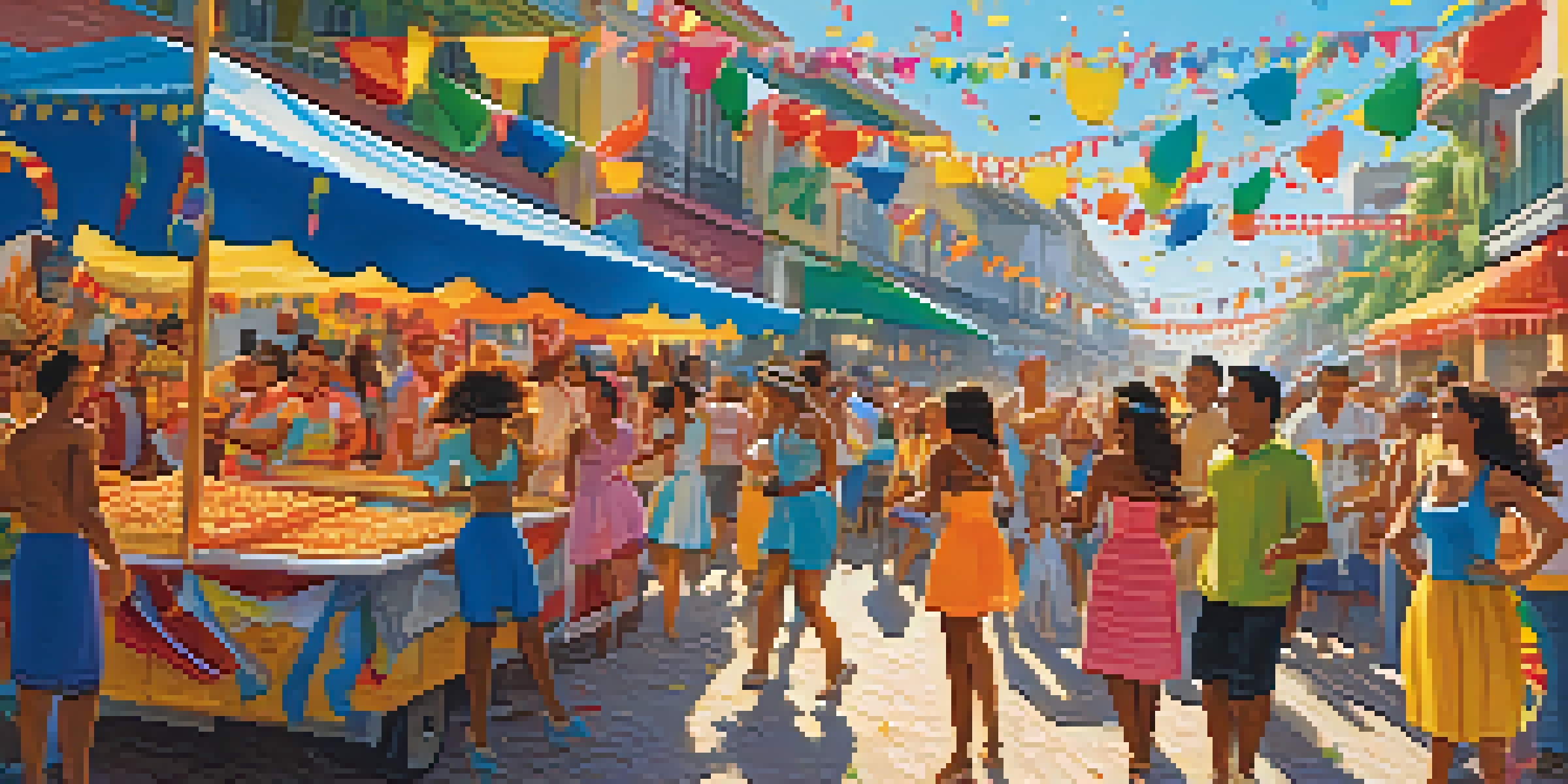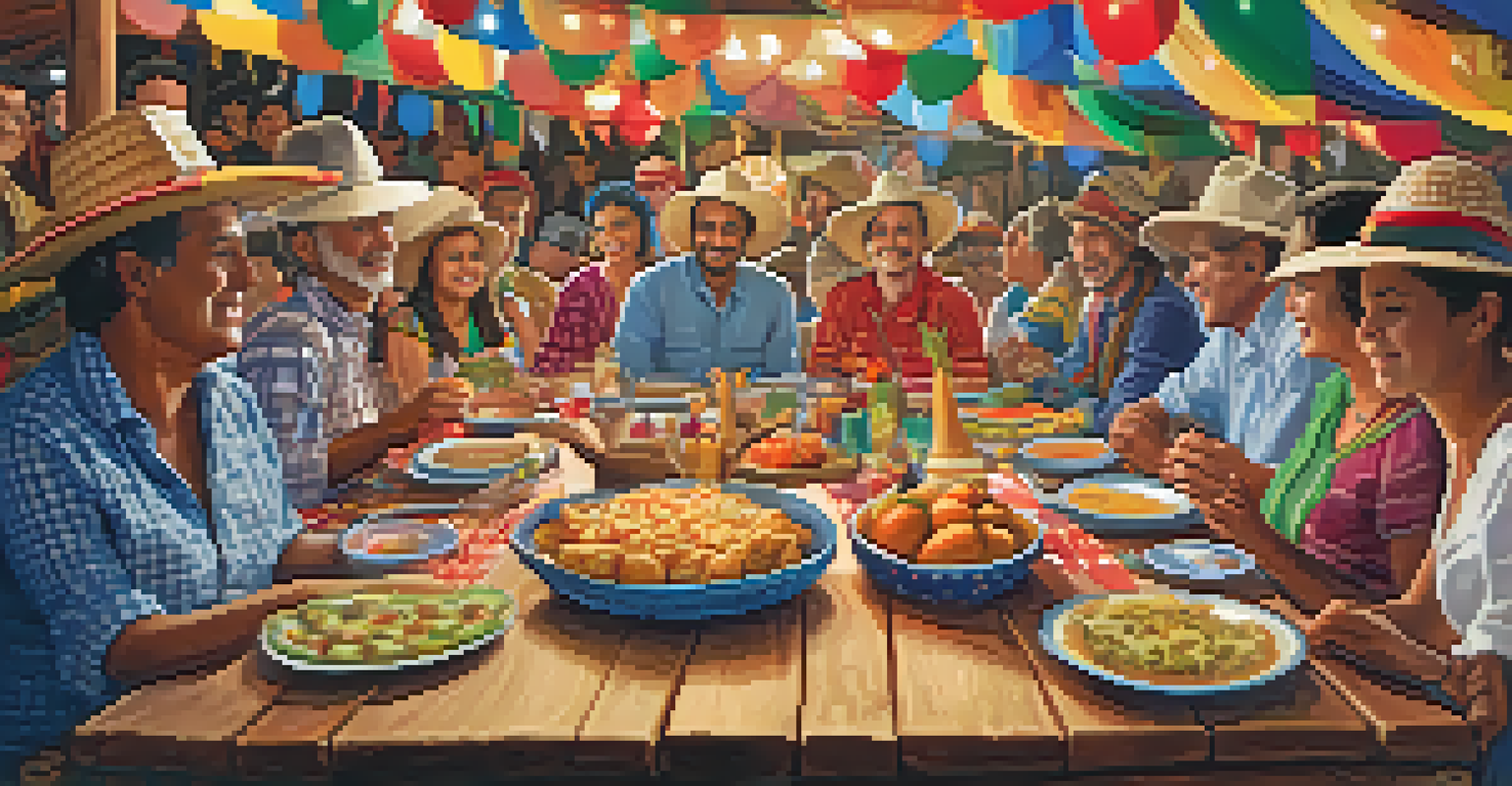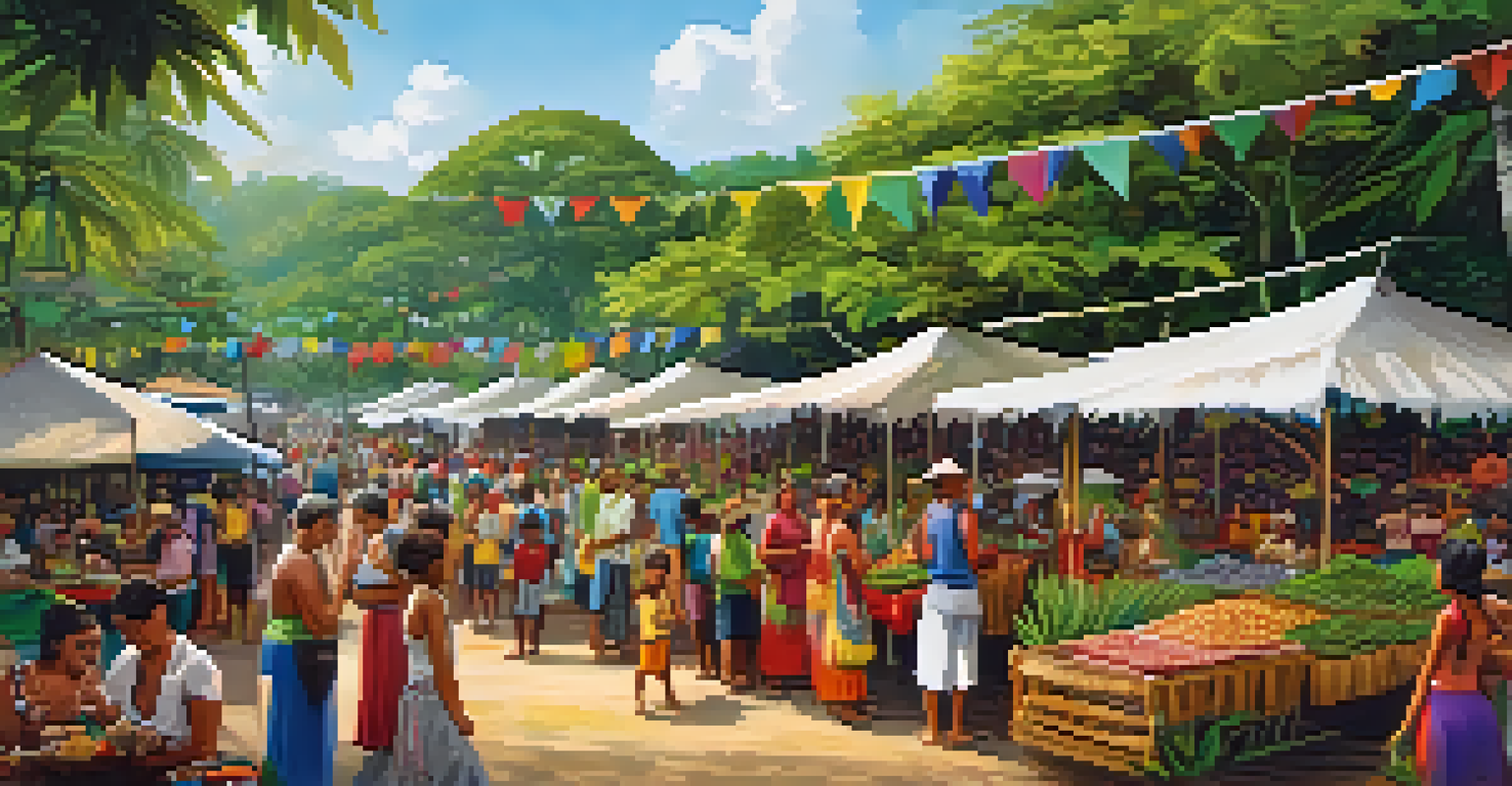Food as Culture: Culinary Delights at Brazilian Festivals

Brazil's Rich Culinary Heritage at Festivals
Brazil is a melting pot of cultures, and this diversity shines through in its food. Each festival reflects a unique blend of indigenous, African, and European influences, creating a vibrant culinary tapestry. For instance, during Carnival, you’ll find street vendors serving everything from savory pastéis to sweet cocadas, showcasing the country's rich flavors.
Food is a central part of every festival, an edible expression of cultural identity.
As you wander through the festival streets, the aroma of grilled meats, fresh fruits, and spices dances in the air, inviting you to indulge. These culinary delights are not just meals; they are a celebration of the traditions and stories behind each dish. This connection to heritage makes festival foods particularly special.
Moreover, the communal nature of these gatherings enhances the experience. Families and friends come together to share meals, reinforcing bonds while enjoying the diverse tastes of Brazil. It's more than just food; it's about coming together as a community to celebrate life.
The Festive Spirit of Junina Celebrations
One of the most beloved festivals in Brazil is Festa Junina, celebrated in June. This festival is characterized by its joyful atmosphere and traditional foods that evoke nostalgia and warmth. Dishes like pamonha (a sweet corn treat) and quentão (a warm spiced drink) are staples that bring people together.

During Festa Junina, elaborate decorations mimic rural life, and people dress in traditional attire, adding to the festive spirit. The food served is often homemade, showcasing family recipes passed down through generations. This emphasis on tradition highlights how food plays a pivotal role in cultural identity.
Brazil's Festivals Celebrate Culinary Diversity
Festivals in Brazil showcase a rich blend of indigenous, African, and European culinary traditions, making food an integral part of cultural celebrations.
As music fills the air and dancers twirl in celebration, the culinary offerings serve as a delicious reminder of Brazil's agricultural roots. Each bite tells a story, connecting festival-goers to their past and to each other, making the experience all the more enriching.
Savoring the Flavors of Carnival
Carnival is perhaps the most famous festival in Brazil, renowned not just for its vibrant parades but also for its culinary delights. The streets come alive with the sounds of samba, and food stalls line the route, offering an array of tantalizing options. From feijoada, a hearty black bean stew, to churros filled with delicious chocolate, there's something for everyone.
The discovery of a new dish does more for the happiness of mankind than the discovery of a star.
The festival's energy is mirrored in its food—bold, flavorful, and meant to be shared. Street food is a key component, allowing attendees to grab a bite on the go while soaking in the lively atmosphere. Sharing these dishes with friends amplifies the joy of the celebration.
Food during Carnival is not merely sustenance; it embodies the festive spirit and cultural pride of Brazil. Each dish is a reflection of the country's diversity, making the culinary experience just as memorable as the dazzling parades and performances.
Culinary Traditions of the Parintins Folklore Festival
In the Amazon, the Parintins Folklore Festival celebrates local culture, music, and, importantly, food. This festival showcases the rich culinary heritage of the region, highlighting ingredients sourced directly from the rainforest. Dishes like tambaqui fish and açaí bowls are not only delicious but also deeply tied to local tradition.
During this vibrant festival, food becomes an integral part of storytelling, as local legends are brought to life through performances and culinary showcases. The community bonds over shared meals, reinforcing connections to their land and culture. Each dish served is a testament to the rich biodiversity of the Amazon.
Community and Tradition in Festival Foods
Many festival dishes are rooted in family traditions and communal sharing, emphasizing the importance of togetherness and cultural identity.
As the festival unfolds, the flavors of the Amazon captivate visitors, inviting them to experience the region's unique culinary identity. This fusion of culture and cuisine exemplifies how food serves as a bridge between the past and present, celebrating the community's heritage.
Delicious Discoveries at the Festa do Peão de Barretos
The Festa do Peão de Barretos is a celebration of Brazilian cowboy culture, and it features an impressive array of traditional foods. From hearty barbecued meats to sweet corn cakes, the festival showcases the flavors of the rural heartland. Visitors flock to enjoy these culinary delights while enjoying rodeo shows and live music.
Barbecue, known as 'churrasco,' is a highlight here, reflecting the gaucho traditions of the region. The communal aspect of sharing a meal around a fire adds to the festival's charm, as families and friends come together to enjoy the experience. This sharing of food creates lasting memories and strengthens community ties.
Moreover, the festival's atmosphere is charged with excitement, and the food complements the thrill of the events. Each bite of the local specialties provides a taste of Brazilian culture, making the Festa do Peão de Barretos a must-visit for food and culture enthusiasts alike.
Influence of Indigenous Cuisine at Festivals
Indigenous cuisine plays a vital role in shaping Brazil's culinary landscape, especially during festivals. Many events incorporate traditional ingredients and cooking methods that have been passed down through generations. Dishes featuring cassava, fish, and tropical fruits are often highlighted, showcasing the bounty of Brazil's natural resources.
This connection to indigenous culture is profound, as it emphasizes sustainability and respect for the environment. By celebrating these traditional foods at festivals, Brazil honors its roots and acknowledges the wisdom of its indigenous peoples. This is particularly evident in festivals like the Festival of the Amazon.
Regional Flavors Highlight Brazil's Richness
Each region of Brazil offers unique culinary specialties during festivals, allowing attendees to experience the country's diverse flavors and heritage.
As festival-goers savor these dishes, they also engage with the stories behind them, fostering a deeper appreciation for the cultural significance of food. This blending of old and new not only enriches the culinary experience but also helps preserve important traditions.
Exploring Regional Flavors Across Brazil's Festivals
Brazil is vast, and each region boasts its own unique culinary offerings, especially during festivals. From the spicy dishes of the Northeast to the fresh seafood of the South, there's a rich variety of flavors to explore. Festivals provide the perfect opportunity to taste these regional specialties all in one place.
For example, the Bahia region showcases its famous moqueca, a seafood stew made with coconut milk and palm oil, reflecting the African influence on its cuisine. Meanwhile, in the South, you'll find traditional chimarrão, a herbal tea served in a gourd, often enjoyed during community gatherings. These regional variations highlight the country’s culinary diversity.

By attending festivals, food lovers can embark on a gastronomic journey across Brazil, experiencing local ingredients and cooking styles. This exploration not only tantalizes the taste buds but also deepens one's understanding of Brazil’s rich cultural heritage.